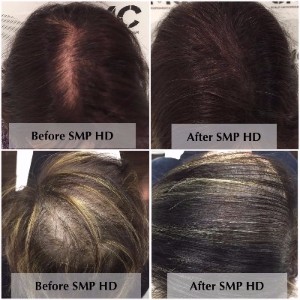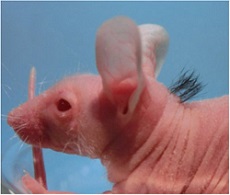Scalp micropigmentation (SMP) has become all the rage in recent years. Since I first wrote this post in May 2017, I have received regular feedback from SMP clinics. Readers have also continued to inquire about scalp micropigmentation, including its effectiveness and side effects. The rise of SMP for male and female pattern baldness sufferers continues to garner news coverage in 2021.
Previously, I wrote a post on tricopigmentation, a temporary form of scalp micropigmentation. In that article, I promised to write a post on actual permanent SMP in the future and here it is. I am quite surprised by the significant number of people who have e-mailed me about this subject over the past few years. Update: Also make sure to read my thoughts on microblading.
For many people, scalp micropigmentation is a great short-term solution to cover their baldness and move on with their lives. If you ever decide to get a SMP procedure (also known as hair tattoo), it is imperative to look at provider reviews and client testimonials online before proceeding. Ideally, you want to go to someone who also offers scalp micropigmentation training to other practitioners.
What is Scalp Micropigmentation?
Scalp micropigmentation is a non-surgical cosmetic procedure for both men and women of all ethnic types who are suffering from hair loss. Beauty Care Nederland has kindly shared the below before and after SMP image with me.

Other lesser used terms for SMP include: scalp tattooing; micro scalp pigmentation; micro hair pigmentation; and micro hair tattooing.
The SMP procedure creates an illusion of hair via the injection of thousands of pigment dots into the scalp. The incisions are typically to a depth of around 2 mm. Right to the point where the upper skin layer (epidermis) meets the lower skin layer (dermis). Rassman et al. concluded that scalp micropigmentation is a good nonsurgical concealer for hair and scalp deformities.
Different clinics use different type of pigments and typically tend to keep their proprietary ingredient combinations secret. The needles used in scalp micropigmentation are much smaller than in regular tattooing. One of our favorite hair loss researchers, Dr. Rachita Dhurat, recently published an important study on standardizing the SMP procedure.
While the scalp micropigmentation procedure is advertised as being “permanent”, the ink marks in SMP can often fade over a few years. Most people will require minor touch-up procedures once a year or two. However, it should be noted that in some patients, the SMP procedure can truly be very long lasting. So one should never assume that the ink will always fade significantly in 5 or more years.
Factors that affect how rapidly the SMP inks fade include:
- A person’s immune system.
- The type of pigments that were utilized.
- The depth of injections (made by human or machine).
- The amount of time the person spends outdoors in inclement weather.
Scalp Micropigmentation Cost
As of 2019, costs for a typical scalp micropigmentation treatment range from $1,000 to $5,000 depending on clinic. In Euros, this cost would translate to €800 to €4,000. Reddit SMPchat has more current information on what people paid for their SMP procedures.
If a totally bald person wants to cover his or her entire head, prices will be substantially higher. In contrast, if someone wants to just cover up their crown region or any type of scar on their head (e.g., a strip hair transplant scar at the back), scalp micropigmentation prices will be much lower.
Initial treatment typically consists of three sessions spread across 2-3 months. SMP costs will be substantially cheaper in poorer countries where there are often fewer regulations. Irrespective of cost, it is imperative to check out scalp micropigmentation provider reviews before proceeding.
Main Applications
Scalp micropigmentation is in demand for four main reasons:
- To date, the most common use has been in creating the illusion of hair (stubble) on a shaven head. i.e., creating a shadow effect on a balding scalp that has been shaven or given a “buzz cut”. This process camouflages areas of hair loss and can give a person a full well defined frontal hairline if desired. People with patchy areas of baldness due to alopecia areata are also great candidates for SMP.
- To increase hair quantity by covering up balding regions of the scalp. This is an increasingly popular option for women who want to maintain long hair and cover up any small visible balding regions with permanent ink.

Scalp Micropigmentation in Women For most, this turns out to be a more efficient option in comparison to daily covering up via hair loss concealers. The Scalp Micropigmentation Center in Canada (photo on right) calls their version of this option “SMP HD”. The “HD” stands for hair density.
- To cover scars from hair transplants, burns and other injuries.
- To enhance the appearance of a hair transplant procedure.
Scalp Micropigmentation versus Tricopigmentation
The main difference between scalp micropigmentation (SMP) and tricopigmentation is that while the former is permanent, the latter is temporary. However, the definition of “permanent” and “temporary” varies depending on clinic and depending on technique used.
In general, “temporary” tricopigmentation ink marks can last anywhere from 6 months to 2-3 years. On the other hand, the so-called “permanent” ink marks in SMP can start to fade after 1-2 years. Thereafter, one will require minor touch-up procedures. In general, SMP is cheaper than tricopigmentation in the long run. The former will require less maintenance and fewer repeat procedures. Future maintenance treatments are also much shorter in duration than the original treatment session.
SMP ink is injected into the scalp at a depth of around 2 mm. This is significantly deeper than the 0.5 mm injections involved in tricopigmentation procedures. Scalp micropigmentation is therefore riskier than tricopigmentation. Nevertheless, as far as I could gauge from reading online testimonials, the majority of people who get scalp micropigmentation seem to be reasonably happy with the results. The advantages outweigh the disadvantages.
Reviews
However, online reviews for both SMP and tricopigmentation are not anywhere near as prevalent as online testimonials for hair transplant procedures. Especially when it comes to discussion forums. Over the coming years there will inevitably be more complaints from dissatisfied patients who went to sketchy clinics. Or some who just got plain unlucky despite going to highly reputable practitioners.
The majority of hair transplant surgeons in the US who are adding scalp tattooing procedures to their offerings seem to prefer tricopigmentation over scalp micropigmentation. However, many still offer both options.
SMP Tattoo Artist Opinions
According to the highly experienced Nicole Large of the Shapiro Medical Group in the US:
“We offer both trico and “perm SMP” procedures. I use them interchangeably and consult first with the patient and evaluate their needs and then I choose which procedure the patient is best fit for. Some people have a TON of anxiety it’s a no-brainer to start with trico and then transition them over in maintenance treatments to perm.
I have some patients who are young and who want a thickening look but they are on no meds to prevent future loss – I choose trico. If I have a patient with a full head of transplanted hair and they want a thickening look then we go with permanent because that hair is not going to fall. I still stand by trico as the safer method because it is a standardized procedure with a pigment that offers a full ingredient list.
If the system is followed correctly the chances of error are much, much lower. I have developed a permanent procedure that is safe and that I like but still have no ingredient list with my pigments. We have no problems with discoloration or migration but my protocols are very safe. I always err on the side of caution. Quite honestly, pigment migration and discoloration is often technician error by injecting too deep, or choosing a color that is too dark.
There are other permanent clinics that I have visited that I think are also doing safe and ethical, and awesome work. Some people have it figured out and others still haven’t. Really they are both great procedures if performed in the right hands.
Mostly they just appeal to different patients. It’s important at this point in time to really find a tech with experience because the market for teaching is absolutely blowing up. You can go take a 3 day course with some yahoo who hasn’t done more than 20 patients themselves and get certified. It’s a joke and it’s very scary”.
One famous clinic named Scalp Micro USA has particularly useful YouTube videos on scalp micropigmentation.
Removing Scalp Ink Marks with Lasers
In my opinion, a person should always assume that his/her scalp micropigmentation ink/tattoo marks can never be entirely removed. Even with a laser, inks market will fade, but not disappear. If one is dissatisfied with the original results or has side effects from a micropigmentation procedure, it is best to be cautious when deciding on the next step. Having said that, if done correctly, SMP marks can usually be removed with lasers down the road.
According to Isabelle van Rijn of the popular Beauty Care Nederland (which offers both the temporary and permanent procedures):
“Scalp micropigmentation can usually be removed with the use of a good laser” provided that the original procedure was done correctly. In her own words: “The pigments must be placed correctly! If too deep, the pigment won’t fade and will turn blue, which is then difficult to treat with laser”.
According to Nicole Large:
“Most “permanent smp” does fade too but it fades to grey and needs to be lasered for a full removal. As long as the clinic is using a “scalp pigment” it should laser off in 1-2 sessions but if they are using permanent makeup could be up to 12+ times”.
A word of warning: if your SMP is mixed in with existing hair in certain areas of the scalp, laser removal of those pigment marks could then also very likely permanently damage the existing native hair in the same region. Usually not something anyone would want.
SMP in Men versus Women
Historically, the scalp micropigmentation market was dominated by men who wanted the fashionable “shadow” look that indicates a full head of hair. However, an increasing number of women are getting SMP in order to make their long hair appear denser and fuller by covering the in-between thinning regions with ink. According to Tino Barbone of the Scalp Micropigmentation Center in Toronto, Canada:
“I’ve seen a huge rise in women coming in to have SMP. The reason why women are perfect for this treatment is because they have a lot more hair than men, and they keep it longer. Therefore, the camouflage of our hair density treatment looks outstanding. Our ladies that have done this treatment use 90 percent less powder and fiber type camouflaging products, and some have stopped using those entirely.
They usually use the powders and fibers for special occasions when they want to add more volume to their hair, but they don’t need to spend hours in the mirror anymore putting it on. My guess, and what I’ve seen thus far, is that women will outweigh men for this treatment in the coming years”.
Pigment Types
Most clinics will not divulge the ingredients in the types of pigments that they use during a scalp micropigmentation procedure. However, all reputable clinics use natural pigments that are not harmful to the skin. Most will also be using an assortment of shades of inks.
According to Tino Barbone:
“Our pigments contain Carbon, Glycerin, sodium hydroxide and water”.
If I get any more detailed information from clinics regarding chemical composition of inks and so forth, I will add it here.
People in the SMP Industry
A number of people in the SMP industry deserve a special mention.
- The highly experienced Nicole Large from the Shapiro Medical Group sent me an unending supply of information via many e-mails. The vast majority of which I could not cover in this post due to my self-imposed length restriction. Nicole has trained with and visited numerous renowned scalp tattooing clinics worldwide. I have also read her name a lot on hair loss forums in the past. She offers both temporary and permanent SMP, although a sizable majority of her clients go for temporary.
- Isabelle van Rijn of Beauty Care Nederland sent me some excellent material, a lot of which I could not cover in this post. Her clinic currently treats around 400 patients every year, and they offer both SMP and tricopigmentation.
- Tino Barbone of The SMP Center in Toronto, Canada sent me a great deal of information on permanent SMP. I was very impressed by some of his responses in a detailed magazine interview that he gave. Make sure to check his clinic’s numerous instagram photos and videos.
- His Hair Clinic (UK) was supposedly the world’s first company to offer SMP starting in 2002. So I had to mention them. On their website, they list the acronym SMP as a registered trademark, although I have seen numerous other clinics use that acronym too. The company’s founders, Ian Watson and Ranbir-Rai Watson, are proclaimed to be the inventors of SMP. However, I would guess that numerous others must have tried permanent scalp tattooing many decades earlier. None of them likely perfected or patented their techniques.



